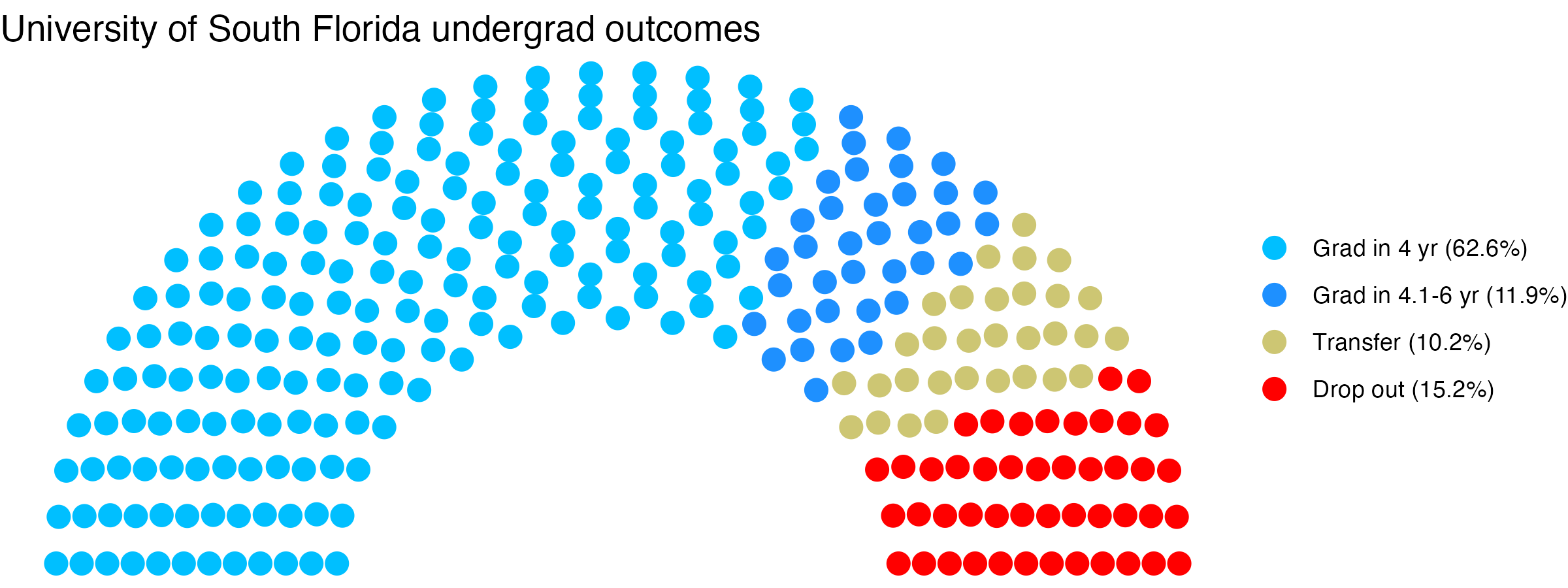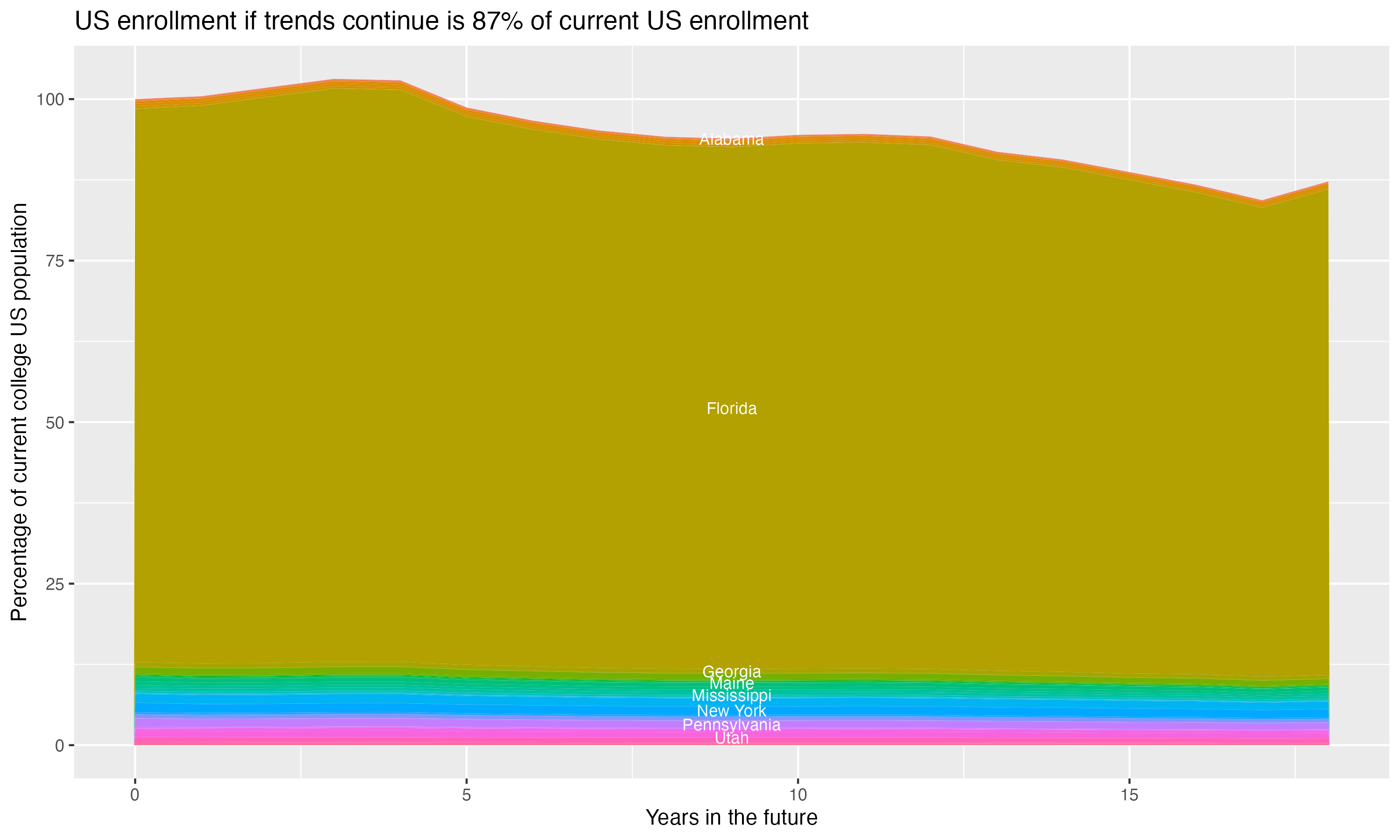University of South Florida-Main Campus
University of South Florida is located in Tampa, Florida. It is a public, 4-year or above institution.
From Wikipedia: The University of South Florida (USF) is a public research university with its main campus located in Tampa, Florida, United States, and other campuses in St. Petersburg and Sarasota. It is one of 12 members of the State University System of Florida. USF is home to 14 colleges, offering more than 240 undergraduate, graduate, specialist, and doctoral-level degree programs. USF is classified among “R1: Doctoral Universities – Very high research activity” and is accredited by the Commission on Colleges of the Southern Association of Colleges and Schools. USF is a member of the Association of American Universities (AAU) and is designated by the Florida Board of Governors as one of three Preeminent State Research Universities. Founded in 1956, USF is the fourth largest university in Florida by enrollment, with 49,766 students from over 145 countries, all 50 states, all five United States Territories, and the District of Columbia as of the 2022–2023 academic year. In 2022, the university reported an annual budget of $2.31 billion and an annual economic impact of over $6 billion. According to the National Science Foundation, USF spent $568 million on research and development in 2019, ranking it 43rd in the nation and 25th among public universities. USF’s $889 million endowment is the third-largest among Florida public universities and the largest of any American public university founded post-World War II. In its 2018 ranking, the Intellectual Property Owners Association placed USF 1st in Florida, 7th in the United States, and 16th worldwide in the number of US patents granted. USF faculty, staff, students, and alumni collectively hold over 2,400 patents. USF is home to the National Academy of Inventors and the Florida Inventors Hall of Fame, both located in the USF Research Park in the southwest side of campus. USF’s sports teams are known as the South Florida Bulls and primarily compete in the American Conference of NCAA Division I. USF’s 21 varsity teams have won a combined 6 national championships and 171 conference championships. Athletes representing the Bulls have won an additional 24 individual and relay national championships and 256 individual and relay conference championships.
Overview of institution
This, and the rest of the page, use info from the most recent year available, generally 2024.
Institution kind: Doctoral Universities: Highest Research Activity
Undergrad program: Balanced arts & sciences/professions, high graduate coexistence
Graduate program: Research Doctoral: Comprehensive programs, with medical/veterinary school
Enrollment profile: High undergraduate (see more details below)
Average net price for undergrads on financial aid: $11,578 . This is 60% the average cost of Harvard.
Actual price for your family: Go here to see what your family may be asked to pay. It can be MUCH lower than the average price but also higher for some.
Size and setting: Four-year, large, primarily nonresidential
In state percentage: 80% of first year students come from Florida
In US percentage: 94% of first year students come from the US
Graduation rate (within 6 years) for students seeking a Bachelors: 74.6% (this is what is usually reported as “graduation rate”)
Graduation rate (within 4 years) for students seeking a Bachelors: 62.6%
Percent of students seeking a Bachelors who transfer out of this institution: 10.2%
Student to tenure-stream faculty ratio: 30.1 (undergrads to tenure-stream faculty) [Tenure explained]
Student to faculty ratio: 13.7 (undergrads to all faculty)
Degrees offered: Associate’s degree, Bachelor’s degree, Master’s degree, Post master’s certificate, Doctor’s degree: research scholarship, Doctor’s degree: professional practice
Schedule: Semester
Institution provides on campus housing: Yes
Dorm capacity: There are enough dorm beds for 7422 students
Freshmen required to live on campus: No
Advanced placement (AP) credits used: Yes
Disabilities: 6.49 percent of undergrads are registered as having disabilities.
Undergrad outcomes
This plot shows the outcomes for first time, full time undergraduates seeking Bachelor’s degrees (if the data are available).

Map
Comparisons
The sections below show this institution compared with others. The ones listed are ones it has identified as peers, who consider themselves peers, and/or who the federal government considers peers. If a comparison school has the same value as the focal school, its cell is grayed out. In fields where there is a common view that higher (or lower) values are better, the best values are in blue, the worst values are in red. If there isn’t a sense of a particular value being better, values are shown in varying shades of green. Arrows show where there is a signficant trend over time for a school. You can swipe across the table to see more of it; the focal school column is always visible.
- University of South Florida lists these schools as ones to compare itself within federal IPEDS data, and they do the same back: Florida State University, University of Central Florida, Rutgers University-New Brunswick, University of Pittsburgh-Pittsburgh Campus, Stony Brook University, University of Cincinnati-Main Campus, University of Illinois Chicago, University of Alabama at Birmingham
- University of South Florida compares itself to these institutions, but not vice versa: University of Florida, Georgia Institute of Technology-Main Campus, University of Georgia, University of California-San Diego, University of California-Irvine, North Carolina State University at Raleigh, Virginia Polytechnic Institute and State University, University at Buffalo, Arizona State University Campus Immersion, University of Utah, Colorado State University-Fort Collins
- These institutions compare themselves to University of South Florida, but not vice versa: University of Wisconsin-Madison, Purdue University-Main Campus, San Diego State University, University of Puerto Rico-Mayaguez, Binghamton University, Florida International University, Texas Tech University, University of Missouri-Columbia, University of Houston, Iowa State University, University of Hawaii at Manoa, Embry-Riddle Aeronautical University-Daytona Beach, Temple University, The University of Texas at Arlington, Indiana University-Indianapolis, Virginia Commonwealth University, University of Louisville, Kent State University at Kent, University of Nevada-Las Vegas, University of Missouri-St Louis, University of Missouri-Kansas City, Embry-Riddle Aeronautical University-Prescott, University of New Mexico-Main Campus, University of Memphis, Augusta University, Walden University, Florida Polytechnic University, DeVry University-Florida, Warner University, Louisiana State University Health Sciences Center-Shreveport, South University-Tampa
Enrollment

General
Teaching
Tenure track faculty are those who are eligible for tenure. This includes both pre-tenure and tenured faculty. Once faculty get tenure, they are (generally) protected from being fired for intellectual reasons, helping to ensure their freedom in teaching and research. They can still lose their positions for misconduct, financial problems, not fulfilling their duties, or other reasons.
Non-tenure track faculty are not eligible for tenure. Some are hired one semester at a time, some have multi-year contracts. They typically have a higher teaching load than tenure track faculty, leaving less time for research or other creative endeavors. They are also easier to fire than tenured faculty. Sometimes they are external experts (a noted musician, a former senator) who are hired to teach some classes without the expected permanence of a tenure-track position.
Note that this chart uses US federal demographic data: it only has two genders and a specified set of ethnicities and races.
Having a low student to faculty ratio is considered a good thing by many, as it can mean more individual attention.
Geography
This has information on the location of the institution. See the about page for more information on what the metrics are and how they are calculated.
Financial Aid
Graduation
Note these are bachelors graduation rates in six years, not four (this is standard). Sample sizes can be small for some demographic groups with few individuals in a school, leading to large year-to-year fluctuations and often extreme values for those groups (if there are two individuals in the class with a given identity, the possible graduation rates are 0%, 50%, or 100% depending on whether zero, one, or both students graduate within six years).
Library
Libraries are changing rapidly. Note that how institutions count digital collections may vary.
Diversity
The US Census Bureau has a diversity index that goes from 0 to 1. In their words, “A 0-value indicates that everyone in the population has the same racial and ethnic characteristics. A value close to 1 indicates that everyone in the population has different racial and ethnic characteristics.” This uses their formula, but with the resolution available for the federal IPEDS data (which does not separate for a given demographic group whether members identify as Hispanic or not). This metric is about heterogeneity within the population, not the proportion of the population that comes from historically excluded groups.
Following the practice of the census, the index is multiplied by 100 to give the percentage probability a random pair of individuals will have a different background. Most institutions argue that diversity is a benefit, so by default a higher number is listed as better, but there may be cases where this measure does not reflect the mission of a college (for example, 70% of the students at a tribal college or university may be American Indian: that could be low-scoring by this metric but should not be read as “bad” given the institution’s mission).
These numbers are based on the most recent year available, generally 2024, which predates effects of the US Supreme Court’s striking down of affirmative action. This has often changed, sometimes dramatically, the incoming student demographics at some institutions.
Overall diversity
Freshman profile
Demographic data for first time degree-seeking students. Note that this uses US federal demographic data: it only has two genders and a specified set of ethnicities and races.
Freshman geography
Test scores
SAT scores
ACT scores
Majors
This presents information on the number of majors and the median earnings one and five years after graduation for people who got a degree from this institution in that field. The earnings are for those who are working and not enrolled in further education. The earnings data (from the federal college scorecard) also has information on earnings for those categorized as ‘MALE’ and ‘NOMALE’ – for readability, these are recategorized here as “Men” and “Women”, respectively, which adopts the gender binary used in other federal data. “W/M earnings ratio” is the median earnings of women divided by men, as a percentage.
Bachelors
Masters
Doctorate
Certificate
Associates
Demographic cliff
There is a concern that giving changing US demographics, the number of students in the age groups who most commonly attend four year colleges will drop off, decreasing overall enrollment. This is often referred to as the “demographic cliff”, and it can be a concern for colleges concerned about the risk of falling enrollment. For this section, the analysis uses US census data on the number of people in each state by age, and the proportion of students that come from each state for this particular college, to crudely model what will happen if everything remains constant except the demographic change in the population of 18 year olds in each year – it does not account for things like the college increasing its admission rate, attracting more students from states without the same demographic changes or from other countries, or changes in the proportion of students who go to college.
